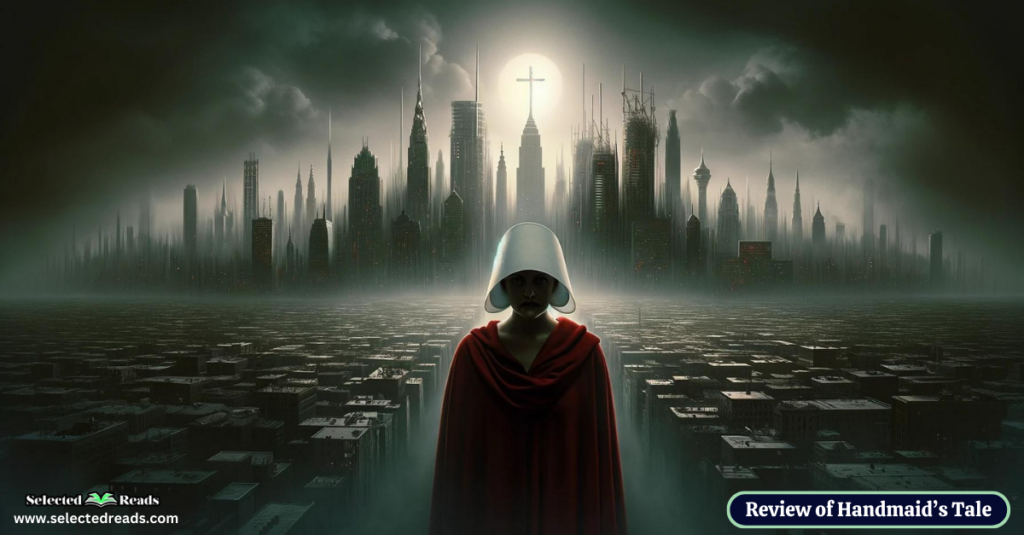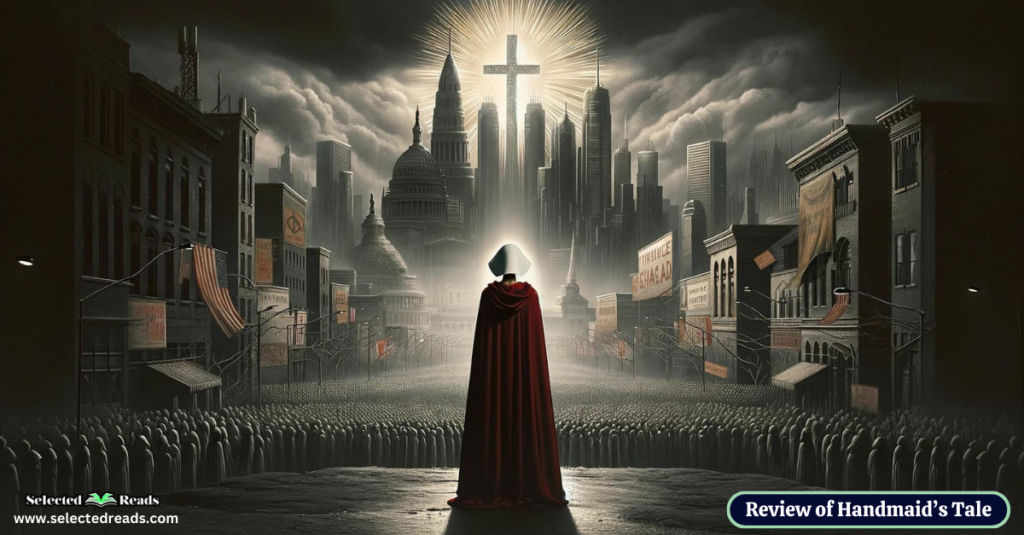In today’s post, we’re diving deep into the chilling and ever-relevant world of Margaret Atwood’s dystopian masterpiece, “The Handmaid’s Tale.” Since its publication in 1985, this novel has captivated, disturbed, and inspired readers and critics alike, painting a stark portrait of a future that feels unnervingly possible. Atwood’s tale of the Republic of Gilead, a totalitarian regime that reduces women to their reproductive functions, is a powerful exploration of gender, power, and resistance.
Our discussion will proceed as follows: First, we’ll provide an extended summary of the novel, setting the stage for those who haven’t yet encountered its haunting narrative or wish to revisit the story with fresh eyes. This will give us a solid foundation to explore the complex characters that populate Gilead. Following our character analysis, we’ll delve into a curated list of book club questions designed to spark thoughtful discussion.
So, whether you’re a longtime fan of Atwood’s work, a concerned observer of our current societal trajectory, or someone who loves to engage with thought-provoking literature, this post aims to enrich your understanding of “The Handmaid’s Tale” and encourage meaningful conversations about its themes.
Related: The Handmaid’s Tale Quotes
The Handmaid’s Tale Summary
Margaret Atwood’s “The Handmaid’s Tale,” first published in 1985 and then re-released in paperback in March 1998, stands as a towering achievement in contemporary literature, seamlessly weaving together elements of dystopian fiction, feminist critique, and political commentary.
Set against the backdrop of a future America transformed into the totalitarian regime of the Republic of Gilead following environmental catastrophes and a dramatic plunge in birth rates, Atwood’s narrative is chilling in its prescience and meticulous in its construction. The Republic of Gilead, emerging from the ashes of a Second American Civil War, is a society built on the foundations of oppression, where theocratic tyranny dictates every aspect of life, particularly the roles and rights of women.
At the heart of this narrative is Offred, a Handmaid whose sole purpose in this new world order is to bear children for the elite. Stripped of her past life, including her husband, her child, and even her name—Offred, meaning “Of Fred,” indicating possession—her story is one of resilience, resistance, and the unyielding human spirit. Through Offred’s eyes, Atwood explores themes of power, gender dynamics, and the loss of identity, making “The Handmaid’s Tale” a profound examination of the socio-political issues that continue to resonate today.
Photo: Amazon
What makes Atwood’s work particularly compelling is her ability to blend stark, horrifying realities with a narrative that is at times intimate, reflective, and imbued with a subtle hope. Offred’s memories of her life before Gilead serve as a poignant reminder of the freedoms lost, but also as a spark of defiance against the oppressive regime.
Beyond its narrative and thematic depth, “The Handmaid’s Tale” is also a marvel of storytelling, characterized by Atwood’s sharp wit, nuanced character development, and a suspenseful plot that keeps readers engaged from start to finish. “The Handmaid’s Tale” is a warning; an exploration of what happens when society relinquishes too much power to those who seek to control and redefine human rights and dignity.
The Handmaid’s Tale Characters
Let’s delve into some of the key characters and their roles within this narrative.
- Offred: The protagonist of the story, Offred serves as the lens through which we view the horrors of Gilead. A Handmaid assigned to a high-ranking official, the Commander, her primary role is to bear a child for him and his wife, Serena Joy. Offred’s real name is never revealed to us, reflecting the loss of identity and autonomy faced by women in Gilead. Her inner thoughts, memories of the time before Gilead, and her acts of quiet rebellion against the oppressive system are central to the narrative.
- The Commander: A high-ranking official in Gilead’s theocracy, he is the man to whom Offred is assigned as a Handmaid. Despite being a key part of the regime, he shows signs of discontent with its strictures, engaging in forbidden activities with Offred, like playing Scrabble and allowing her to read magazines.
- Serena Joy: The Commander’s wife, she was once a public figure who advocated for “traditional values,” but now finds herself trapped by the very system she helped bring about. Her relationship with Offred is complex, marked by jealousy, desperation, and moments of unexpected complicity.
- Moira: Offred’s best friend from before Gilead, Moira is a symbol of resistance within the novel. Her repeated attempts to escape the regime and her ultimate fate as a worker in Jezebel’s, a brothel that services the elite of Gilead, showcase the limits of resistance within such a repressive system.
- Nick: The Commander’s chauffeur and part of the Mayday resistance, Nick develops a personal relationship with Offred. He is a complex character whose true motives and loyalties remain ambiguous throughout the novel.
- Aunt Lydia: One of the Aunts responsible for indoctrinating the Handmaids into their new roles, Aunt Lydia is a figure of authority and a true believer in Gilead’s ideology. She embodies the paradox of women who enforce the patriarchal and misogynistic laws of Gilead.
- Janine/Ofwarren: Another Handmaid who represents the psychological toll Gilead takes on women. Her story is a tragic one, showcasing the devastating effects of the regime’s cruelty and the pressure to conform.
The Handmaid’s Tale Book Club Questions
Here are some questions that can help spark a lively and insightful discussion:
- Themes and Symbolism: How do the themes of power, control, and resistance manifest throughout “The Handmaid’s Tale”? Discuss the significance of symbols such as the color red, the eye, and the flower garden in the novel. How do these symbols contribute to the overall narrative?
- Character Analysis: Offred’s character is complex and multifaceted. Discuss how her memories of the past influence her actions and resilience in the present. How do her relationships with other characters, such as Moira, Serena Joy, and the Commander, reveal different aspects of her character and the society of Gilead?
- Societal Commentary: “The Handmaid’s Tale” is often seen as a commentary on the dangers of extreme patriarchal societies and the suppression of women’s rights. How does Atwood’s portrayal of Gilead reflect real-world issues? Can you draw parallels between the society in the novel and any historical or current events?
- The Role of Women: Gilead imposes strict roles on women based on their fertility and obedience. Discuss how the roles of Handmaids, Wives, Marthas, and Aunts serve to divide and control women. How do these roles both oppress and empower women in different ways?
- Resistance and Complicity: Throughout the novel, characters exhibit varying degrees of resistance and complicity to the regime of Gilead. Discuss examples of resistance in the novel, such as Moira’s escape attempts and Offred’s small acts of defiance. How do these acts of resistance impact the characters and their survival? Conversely, explore the reasons behind characters’ complicity or acceptance of the regime.
- Narrative Structure: “The Handmaid’s Tale” is told from Offred’s first-person perspective, with frequent flashbacks to her life before Gilead. How does this narrative structure affect your understanding and empathy for Offred and other characters? Discuss the role of unreliable narration in the novel. How might Offred’s perspective shape or limit our understanding of Gilead?
- The Ending: The novel’s ending is ambiguous and has sparked much debate among readers. How did you interpret the ending? What do you believe happens to Offred after the novel’s conclusion, and why? How does the novel’s epilogue, set in the future, change your perspective on the events of the story?
- Adaptations and Relevance: Having become a cultural phenomenon, especially with the recent television adaptation, discuss how the themes of “The Handmaid’s Tale” remain relevant today. Have the adaptations added to or altered your perception of the novel? How does the story resonate with contemporary discussions about women’s rights and autonomy?
Final thoughts
In conclusion, our exploration of Margaret Atwood’s “The Handmaid’s Tale” has taken us through the harrowing streets of Gilead, into the lives of its characters, and deep into the thematic core of this dystopian narrative. We’ve unpacked an extended summary of the novel, providing a clear overview of its plot and setting, a world where freedom is curtailed and individuals are reduced to the roles assigned to them by a totalitarian regime.
Our detailed look at the characters brought us closer to understanding their complexities, motivations, and the survival tactics they employ in a society that seeks to erase their identities. Through our book club questions, we’ve opened the floor to a deeper analysis and discussion, inviting readers to critically engage with the novel’s themes of power, resistance, gender roles, and the importance of storytelling in preserving one’s sense of self and hope.
Margaret Atwood’s masterpiece remains a potent and eerily prescient cultural phenomenon, as relevant today as when it first emerged. It serves not only as a warning but as a beacon, urging us to recognize and cherish our agency and voices.









